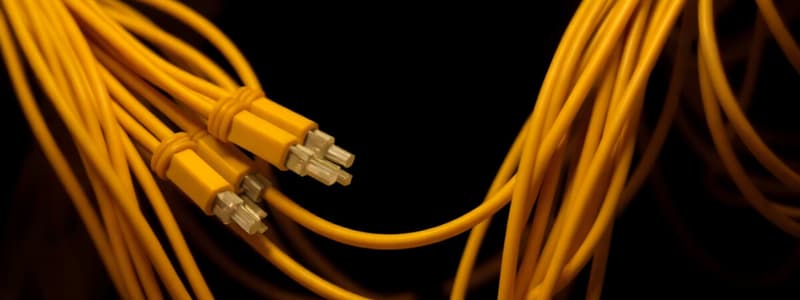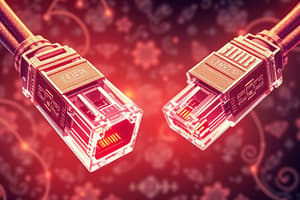Podcast
Questions and Answers
Which category of UTP cable is designed for 10 Gigabit Ethernet transmission over 100 meters?
Which category of UTP cable is designed for 10 Gigabit Ethernet transmission over 100 meters?
- Cat6
- Cat8
- Cat5
- Cat7 (correct)
Which UTP cable category is considered obsolete and not recommended for networking?
Which UTP cable category is considered obsolete and not recommended for networking?
- Cat5e
- Cat3 (correct)
- Cat6
- Cat7
Which type of connector is primarily used with UTP cables in networking environments?
Which type of connector is primarily used with UTP cables in networking environments?
- RJ-45 (correct)
- Fiber Connector
- RJ-11
- BNC
What is a key advantage of fiber-optic cables compared to traditional copper cabling?
What is a key advantage of fiber-optic cables compared to traditional copper cabling?
Which of these UTP cable categories can handle transmissions up to 100 MHz?
Which of these UTP cable categories can handle transmissions up to 100 MHz?
Multimode fiber (MMF) can carry multiple signals at once. What describes the nature of single-mode fiber (SMF)?
Multimode fiber (MMF) can carry multiple signals at once. What describes the nature of single-mode fiber (SMF)?
Which category of UTP cable was used for 10 Mbps Ethernet in the mid-1980s?
Which category of UTP cable was used for 10 Mbps Ethernet in the mid-1980s?
Which characteristic makes fiber-optic cables advantageous for data transmission?
Which characteristic makes fiber-optic cables advantageous for data transmission?
What distinguishes serial cables from other types of cables?
What distinguishes serial cables from other types of cables?
Which of the following is NOT a type of Ethernet wiring standard?
Which of the following is NOT a type of Ethernet wiring standard?
What is the maximum number of devices that can be connected via USB?
What is the maximum number of devices that can be connected via USB?
What is the function of the Main Distribution Frame (MDF)?
What is the function of the Main Distribution Frame (MDF)?
Which cable type would you use for connecting a switch to another switch directly?
Which cable type would you use for connecting a switch to another switch directly?
In network communication, what does duplex refer to?
In network communication, what does duplex refer to?
What is the primary purpose of a demarcation point (demarc)?
What is the primary purpose of a demarcation point (demarc)?
Which of these is an advantage of USB over traditional serial and parallel buses?
Which of these is an advantage of USB over traditional serial and parallel buses?
Which type of cable is covered with a plastic jacket and has a center conductor made of copper?
Which type of cable is covered with a plastic jacket and has a center conductor made of copper?
What is the primary reason that wires in twisted-pair cable are twisted together?
What is the primary reason that wires in twisted-pair cable are twisted together?
Which type of twisted-pair cable has an outer shielding to protect against interference?
Which type of twisted-pair cable has an outer shielding to protect against interference?
Which connector is commonly used with coaxial cables?
Which connector is commonly used with coaxial cables?
What is a defining feature of plenum-rated coaxial cables?
What is a defining feature of plenum-rated coaxial cables?
Which statement accurately describes unshielded twisted-pair (UTP) cable?
Which statement accurately describes unshielded twisted-pair (UTP) cable?
Why is BNC connector crimping preferred in coaxial cable applications?
Why is BNC connector crimping preferred in coaxial cable applications?
What distinguishes fiber optic cables from twisted-pair and coaxial cables?
What distinguishes fiber optic cables from twisted-pair and coaxial cables?
Which type of fiber is typically used for longer-distance applications?
Which type of fiber is typically used for longer-distance applications?
What is a notable disadvantage of fiber-optic cables compared to twisted-pair cables?
What is a notable disadvantage of fiber-optic cables compared to twisted-pair cables?
Which connector type is known for its latching mechanism that secures the connection?
Which connector type is known for its latching mechanism that secures the connection?
Which standard is associated with bidirectional communication over a single strand of fiber?
Which standard is associated with bidirectional communication over a single strand of fiber?
What is a primary use for LC connectors in networking technology?
What is a primary use for LC connectors in networking technology?
What is a key feature of the MT-RJ fiber-optic connector?
What is a key feature of the MT-RJ fiber-optic connector?
What is one of the positive aspects of fiber-optic cables?
What is one of the positive aspects of fiber-optic cables?
What is typically required when converting media types in networking?
What is typically required when converting media types in networking?
Flashcards are hidden until you start studying
Study Notes
Physical Media
- Coaxial cable consists of a copper center conductor, plastic jacket, and braided shield.
- Twisted-pair cable is made of multiple insulated wires twisted in pairs.
- Fiber-optic cable transmits digital signals using light impulses, making it immune to EMI and RFI.
Coaxial Cable
- Plenum-rated coating is often mandated by local fire codes when cable is hidden in walls and ceilings.
Twisted-Pair Cable
- Shielded Twisted-Pair (STP) cable has a metallic shield around the wires for added interference protection.
- Unshielded Twisted-Pair (UTP) cable is more common due to its lower cost and ease of use.
- Twisting the wires together reduces interference (crosstalk) and protects from outside sources.
UTP Cable Categories
- Cat 1: Obsolete, voice-grade only for POTS (Plain Old Telephone Service).
- Cat 2: Obsolete, handles up to 4 Mbps, frequency limitation of 10 MHz.
- Cat 3: Obsolete, handles up to 16 MHz, used for 10 Mbps Ethernet in the mid-1980s.
- Cat 4: Obsolete, rated for 20 MHz.
- Cat 5: Used for 100BaseTX (two-pair wiring), rated for 100 MHz.
- Cat 5e: Enhanced version of Cat 5, supports 1000Base-T (Gigabit Ethernet).
- Cat 6: Supports 1000Base-T and 10 Gbps, rated for 250 MHz.
- Cat 7: Supports 10 Gigabit Ethernet over 100 meters, rated for 600 MHz.
- Cat 8: Supports 40 Gbps and 100 Gbps (over short distances), rated for 2000 MHz.
RJ Connectors
- RJ-11: Used for phones with four wires.
- RJ-45: Has four pairs (eight wires), commonly used for Ethernet connections.
Fiber-Optic Cable
- Single-mode fiber (SMF) carries a single light ray and is used for longer distances.
- Multimode fiber (MMF) carries multiple light rays and is used for shorter distances.
Fiber-Optic Connectors
- ST connector: Widely used, uses a BNC-like attachment mechanism.
- SC connector: Latched mechanism for secure connections.
- MT-RJ: Small form factor connector, commonly replaces SC and ST connectors.
- LC: Newer style of SFF connector, becoming popular for Fibre-Channel adapters and Gigabit Ethernet.
Media Converters
- Convert between different media types (e.g., fiber to Ethernet).
Broadband over Power Line
- Utilizes existing electrical wiring for high-speed internet access.
Serial Cables
- Serial cables transmit one bit at a time, common types include:
- USB (Universal Serial Bus): Most common serial bus on motherboards, flexible and with multiple connections.
Cable Properties
- Factors to consider for cable selection:
- Transmission speeds
- Distance
- Duplex (unidirectional or bidirectional)
- Noise Immunity (resistance to EMI/RFI)
- Frequency
Wiring Standards
- T568B/A: Standardized wiring patterns for RJ-45 connectors.
- Straight-through cable: Used to connect devices of the same type (e.g., PC to hub).
- Crossover cable: Used to connect two devices of the same type directly (e.g., switch to switch).
- Rolled cable (rollover): Used to connect a console port to a router or switch.
- Hardware loopback: Used for testing the network card in a device.
Installing Wiring Distributions
- MDF (Main Distribution Frame): Reference point for telephone lines, WAN termination point.
- IDF (Intermediate Distribution Frame): Smaller wiring point within a building.
- Demarc: Last point of responsibility for the service provider.
Studying That Suits You
Use AI to generate personalized quizzes and flashcards to suit your learning preferences.




